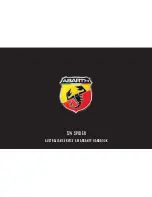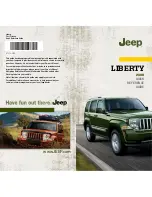
Vehicle features
Vehicle features
Agila
Quick Reference Guide
Refer to Owner’s Manual for detailed information.
Illustrations may depict left-hand drive vehicles.
Operation is similar for right-hand drive vehicles.
Depending on the model variant, special equipment
and accessories, the scope of equipment on your
vehicle may differ from the descriptions in this guide.
TS 1670-B-12
March 2011
1. Side air vents
2. Door window defroster vents
3. Remote control for
infotainment system
4. Turn signals, headlights, rear
fog light
5. Instruments
6. Driver airbag, horn
7. Wiper and washer systems
8. Tachometer
9. Centre air vents
10. Hazard warning switch, control
indicator for front passenger
airbag deactivation
11. Upper tray
12. Infotainment system
13. Front passenger airbag
14. Storage tray
15. Airbag deactivation
16. Glovebox
17. Climate control system
18. Power outlet, cigarette lighter
19. Selector lever
20. Storage tray
21. Ignition switch with steering
wheel lock
22. Steering wheel adjustment
23. Fuse box
24. Bonnet release lever
25. Headlight range adjustment,
front fog lights, Traction
Control System, Stop-start
system
Locking the vehicle:
Manually lock entire vehicle using
the key in driver’s door.
To lock entire vehicle using remote
control press button
e
.
Anti-theft locking system:
To activate: turn key in driver’s
door lock towards rear of vehicle
twice within 3 seconds, or, press
button
e
on remote control twice
within 3 seconds.
Warning: Do not use this system if
there are people in the vehicle, as
the doors cannot be unlocked from
inside.
Electronic immobiliser:
The immobiliser is automatically
activated when the key is turned to
the LOCK position and removed
from the ignition switch.
The immobiliser does not lock the
doors. Therefore, after leaving the
vehicle, always lock it.
Unlocking the vehicle:
Turn key once to manually unlock
driver’s door. Turn key twice in door
to unlock entire vehicle.
To unlock driver’s door, press
button
c
on remote control once.
Press twice to unlock entire vehicle.
Vehicle security
Demisting and defrosting the
windows:
Turn the air recirculation mode
4
off.
Set the temperature control to
the warmest level.
Switch cooling
n
on.
Set the air distribution control to
V
.
Set the fan speed to the highest
level.
Switch heated rear window
Ü
on.
Releasing steering wheel lock:
Turn the key to
ACC
position and
rotate steering wheel slightly to
release lock.
Ignition positions:
LOCK
= Ignition off
ACC
= Steering released,
ignition off
ON
= Ignition on
START
= Start (transmission in
neutral)
Starting the engine:
Turn key to
ACC
position
Move steering wheel slightly to
release steering wheel lock
Manual transmission in neutral
with clutch depressed
Automatic transmission in
P
or
N
with brake pedal depressed
Do not accelerate
Turn key to
START
position
and
release when engine is running
Stop-start system:
The stop-start system helps to save
fuel and reduce exhaust emissions,
and is available as soon as the
engine is started.
Stop-start system activation:
If the vehicle is at low speed or in
standstill, activate an Autostop as
follows:
1. Depress the clutch pedal.
2. Shift the selector lever to
N
.
3. Release the clutch pedal.
The engine will be switched off
while the ignition stays on.
Autostop is indicated when
ENG A-STOP
illuminates green in
the instrument cluster.
To restart the engine, depress the
clutch pedal again.
Stop-start system deactivation:
Deactivate the stop-start system
manually by pressing the
ENG A-
STOP OFF
button. LED in the
button illuminates when the system
is deactivated.
Opening the bonnet:
Pull release lever below instrument
panel on driver’s side and return it
to its original position.
Push the safety catch to the left
and open the bonnet.
Secure the bonnet support.
Before closing, press the support
into the holder, lower the bonnet
and allow it to drop into the catch.
Check that the bonnet is engaged.
Opening the tailgate:
To open the tailgate, press the
button below the handle after
unlocking the vehicle.
Release fuel filler flap:
Release fuel filler flap by pulling up
the release lever located on the
outboard side of the driver’s seat.
Refuelling:
Before refuelling, switch off engine
and any external heaters with
combustion chambers (identified
by sticker on fuel filler flap).
Switch off mobile phones.
Turn the fuel filler cap anti-
clockwise to open.
Wipe off any overflowing fuel
immediately.
Petrol engines - use unleaded fuel
that complies with DIN EN 228.
Fuel tank capacity - 45 litres.
Engine oil:
Check engine oil level manually
every 300 miles or prior to long
journeys, to prevent damage to the
engine. Ensure that the correct
specification of oil is used.
Check with vehicle on a level
surface. Engine must be at
operating temperature and
switched off for at least 5 minutes.
Pull out dipstick, wipe it clean,
insert to the stop on the handle,
pull out and read engine oil level.
Insert dipstick to stop on handle
and make half a turn.
Caution:
It is the owner’s responsibility to
maintain the correct level of an
appropriate quality oil in the
engine.
Tyre pressure:
Check tyre pressures, including the spare, every 14 days and prior to any long journey; tyres should be
checked when cold. This also applies to vehicles with tyre pressure monitoring system.
Always inflate the spare tyre to the value specified for full load.
Incorrect tyre pressures will impair safety, vehicle handling, comfort and fuel economy and will increase tyre
wear.
Tyre pressure (psi)
Comfort setting for load of
upto 3 people
Engine
Tyres
Front Rear
K 10 B,
165/70 R14,
33 33
K 12 B
185/60 R15
33 30
Tyre pressure (psi)
Temporary spare tyre
Engine
Tyre
Front Rear
All
T125/70 R15
61 61
Tyre pressure (psi)
ECO
1)
setting for load of up
to 3 people
Engine
Tyres
Front Rear
K 10 B,
185/60 R15
41 36
K 12 B
1)
Temporary spare not to be used with
ECO tyres
Tyre pressure (psi)
For full load
Engine
Tyres
Front Rear
K 10 B,
165/70 R14,
36 41
K 12 B
185/60 R15
33 38
Tyre pressure (psi)
Temporary spare tyre
Engine
Tyre
Front Rear
All
T125/70 R15
61 61




















